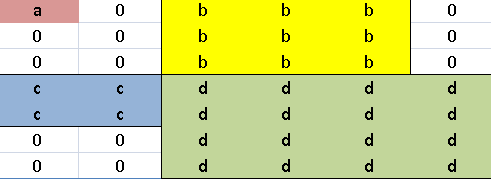所以我有一个对象,由于缺少更好的词,MatricesMatrix 它是矩阵的 Matrix(所有内容都存储为 double[, ])。我想将内部矩阵中的所有值剥离到一个大矩阵中。这是我目前所拥有的:
public Matrix ConvertToMatrix()
{
//Figure out how big the return matrix should be
int totalRows = this.TotalRows();
int totalColumns = this.TotalColumns();
Matrix returnMatrix = new Matrix(totalRows, totalColumns);
List<object> rowElementsList = new List<object>();
//"outer" index means an index of the MatricesMatrix
//"inner" index means an index of a Matrix within the Matrices Matrix
//outer row loop
for (int outerRowIndex = 0; outerRowIndex < NumberOfRows; outerRowIndex++)
{
//outer column loop
for (int outerColumnIndex = 0; outerColumnIndex < NumberOfColumns; outerColumnIndex++)
{
Matrix currentMatrix = GetElement(outerRowIndex, outerColumnIndex);
object element = null;
//inner row loop
for (int innerRowIndex = 0; innerRowIndex < currentMatrix.NumberOfRows; innerRowIndex++)
{
//inner column loop
for (int innerColumnIndex = 0; innerColumnIndex < currentMatrix.NumberOfColumns; innerColumnIndex++)
{
element = currentMatrix.GetElement(innerRowIndex, innerColumnIndex);
}
}
returnMatrix.SetElement(outerRowIndex, outerColumnIndex, (double)element);
}
}
return returnMatrix;
}
请注意,我已经以编程方式确定了 returnMatrix 需要的行数和列数。
这里有一些更多的指南和输出案例:
- 大矩阵的每个元素相对于来自该元素来自的 MatricesMatrix 内部的矩阵的大矩阵的其他元素应该处于相同的位置。
- 大矩阵内的每个“矩阵”(不再是矩阵形式)相对于大矩阵内其他矩阵的位置应该与它在 MatricesMatrix 内的位置相同(没有重叠,并且 0's in任何空格留空)。
案例 1
给定此输入:MatricesMatrix(2,2) 具有 [0,0] = (2x2 矩阵), [0,1] = (2x3 矩阵), [1, 0] = (2x2 矩阵), [1,1] = (2x3 矩阵)。也就是说,

输出必须是:

案例 2
给定此输入:MatricesMatrix(2,2) 具有 [0,0] = (1x1 矩阵), [0,1] = (3x3 矩阵), [1, 0] = (2x2 矩阵), [1,1] = (4x4 矩阵)。也就是说,

输出应该是这样的:

如有任何帮助,我们将不胜感激!
更新: 这是应该通过的案例 1 的单元测试:
[TestMethod]
public void MatricesMatrix_ConvertToMatrixTest()
{
Matrix m1 = new Matrix(2);
Matrix m2 = new Matrix(2, 3);
Matrix m3 = new Matrix(2);
Matrix m4 = new Matrix(2, 3);
double[] m1Row1 = { 1, 1 };
double[] m1Row2 = { 1, 1 };
double[] m2Row1 = { 2, 2, 2 };
double[] m2Row2 = { 2, 2, 2 };
double[] m3Row1 = { 3, 3 };
double[] m3Row2 = { 3, 3 };
double[] m4Row1 = { 4, 4, 4 };
double[] m4Row2 = { 4, 4, 4 };
m1.SetRowOfMatrix(0, m1Row1);
m1.SetRowOfMatrix(1, m1Row2);
m2.SetRowOfMatrix(0, m2Row1);
m2.SetRowOfMatrix(1, m2Row2);
m3.SetRowOfMatrix(0, m3Row1);
m3.SetRowOfMatrix(1, m3Row2);
m4.SetRowOfMatrix(0, m4Row1);
m4.SetRowOfMatrix(1, m4Row2);
MatricesMatrix testMatricesMatrix = new MatricesMatrix(2, 2);
testMatricesMatrix.SetElement(0, 0, m1);
testMatricesMatrix.SetElement(0, 1, m2);
testMatricesMatrix.SetElement(1, 0, m3);
testMatricesMatrix.SetElement(1, 1, m4);
Matrix expectedResult = new Matrix(4, 5);
double[] expectedRow1 = { 1, 1, 2, 2, 2 };
double[] expectedRow2 = { 1, 1, 2, 2, 2 };
double[] expectedRow3 = { 3, 3, 4, 4, 4 };
double[] expectedRow4 = { 3, 3, 4, 4, 4 };
expectedResult.SetRowOfMatrix(0, expectedRow1);
expectedResult.SetRowOfMatrix(1, expectedRow2);
expectedResult.SetRowOfMatrix(2, expectedRow3);
expectedResult.SetRowOfMatrix(3, expectedRow4);
Matrix actualResult = testMatricesMatrix.ConvertToMatrix();
(actualResult == expectedResult).Should().BeTrue();
}
最佳答案
我从一个简单的 Matrix 类开始,用于保存 double[,]。没什么特别的,只是一个简单的数组数组,带有行数和列数以及数组访问器。
class Matrix<T>
{
public int Rows { get; private set; }
public int Cols { get; private set; }
private T[,] mat;
public Matrix(int rowCount, int colCount)
{
Rows = rowCount;
Cols = colCount;
mat = new T[Rows, Cols];
}
public T this[int r, int c]
{
get { return mat[r, c]; }
set { mat[r, c] = value; }
}
}
你的第二种情况看起来比第一种更难(并且更像是正确性测试),所以我设置了一个元矩阵来匹配它。
public static Matrix<double[,]> BuildMetaMatrix()
{
Matrix<double[,]> m = new Matrix<double[,]>(2, 2);
m[0, 0] = new double[,]
{
{ 1 }
};
m[0, 1] = new double[,]
{
{ 3, 3, 3 },
{ 3, 3, 3 },
{ 3, 3, 3 }
};
m[1, 0] = new double[,]
{
{ 2, 2 },
{ 2, 2 }
};
m[1, 1] = new double[,]
{
{4, 4, 4, 4},
{4, 4, 4, 4},
{4, 4, 4, 4},
{4, 4, 4, 4}
};
return m;
}
为方便起见,我制作了一个 Place 函数,可在给定位置将一个矩阵放入另一个矩阵。
static void Place(double[,] src, double[,] dest, int destR, int destC)
{
for (int row = 0; row < src.GetLength(ROW_DIM); row++)
{
for (int col = 0; col < src.GetLength(COL_DIM); col++)
{
dest[row + destR, col + destC] = src[row, col];
}
}
}
输入 GetLength() 的魔数(Magic Number)只是为了找错,所以我为它们定义了一些常量(ROW_DIM = 0 和 COL_DIM = 1)。我决定通过确定列的宽度和行的高度并在 Place() 插入子矩阵后跳过任何额外元素来处理填充。GetRowHeight() 和 GetColWidth() 方法找出值。
public static int GetRowHeight(Matrix<double[,]> m, int row)
{
int maxSeen = 0;
for (int col = 0; col < m.Cols; col++)
{
if (m[row, col].GetLength(ROW_DIM) > maxSeen)
{
maxSeen = m[row, col].GetLength(ROW_DIM);
}
}
return maxSeen;
}
public static int GetColWidth(Matrix<double[,]> m, int col)
{
int maxSeen = 0;
for (int row = 0; row < m.Rows; row++)
{
if (m[row, col].GetLength(COL_DIM) > maxSeen)
{
maxSeen = m[row, col].GetLength(COL_DIM);
}
}
return maxSeen;
}
Flatten() 函数循环遍历所有子矩阵,Place()将它们放置在新矩阵中适当的行和列中。它使用 GetRowHeight() 和 GetColWidth() 函数在每个 Place() 之后更新下一行和下一列。
Matrix<double> Flatten(Matrix<Matrix<double>> src)
{
// (7, 6) == (this.TotalRows(), this.TotalColumns())
// from your code.
Matrix<double> dest = new Matrix<double>(7, 6);
int nextRow = 0;
int nextCol = 0;
for (int row = 0; row < src.Rows; row++)
{
for (int col = 0; col < src.Rows; col++)
{
dest.Place(src[row, col], nextRow, nextCol);
nextCol += GetColWidth(src, col);
}
nextRow += GetRowHeight(src, row);
nextCol = 0;
}
return dest;
}
一点点胶水来测试一下......
static void Main(string[] args)
{
Matrix<double[,]> src = BuildMetaMatrix();
double[,] dest = Flatten(src);
Print(dest);
Console.ReadLine();
}
static void Print(double[,] matrix)
{
for (int row = 0; row < matrix.GetLength(ROW_DIM); row++)
{
for (int col = 0; col < matrix.GetLength(COL_DIM); col++)
{
Console.Write(matrix[row, col] + "\t");
}
Console.Write("\n");
}
}
...你得到的输出就像你的第二种情况,所有奇怪的拟合矩阵和空位的 0。*
1 0 3 3 3 0
0 0 3 3 3 0
0 0 3 3 3 0
2 2 4 4 4 4
2 2 4 4 4 4
0 0 4 4 4 4
0 0 4 4 4 4
*目标矩阵将其值初始化为 default(double),恰好是 0(您想要的值)。如果您需要 default(double) 以外的其他内容作为空位,您可以通过遍历新矩阵并在 Flatten() 之前的任何地方写入新的默认值来获得它们>正在处理元矩阵。
(感谢 Jeff Mercado 指出多维数组的 GetLength() 方法可用于查找它们的维度。)
关于c# - 将二维数组的二维数组转换为单个二维数组,我们在Stack Overflow上找到一个类似的问题: https://stackoverflow.com/questions/24678305/